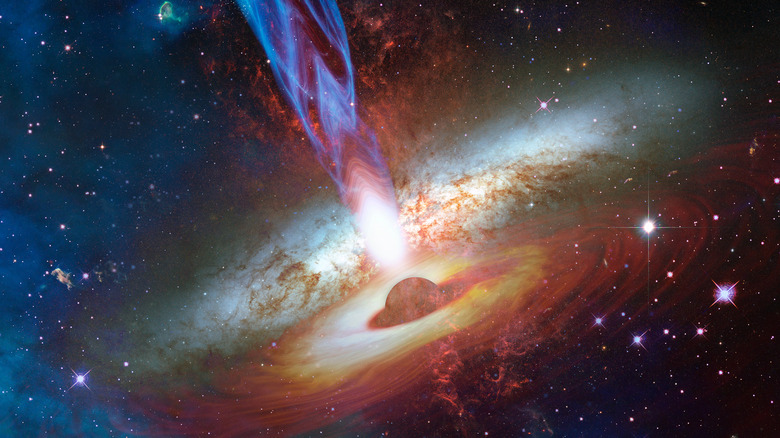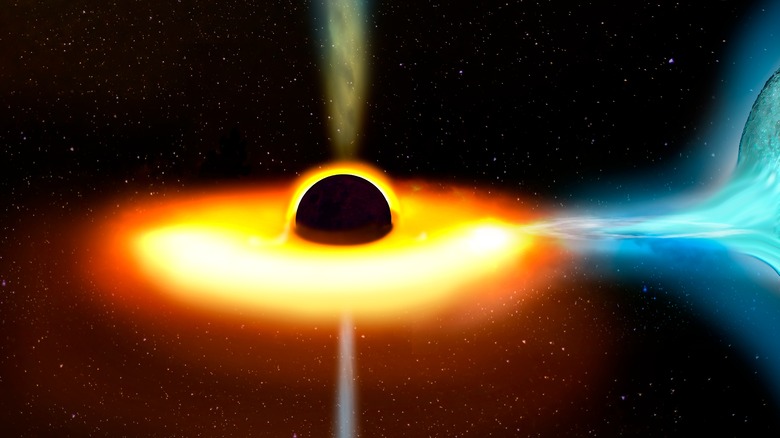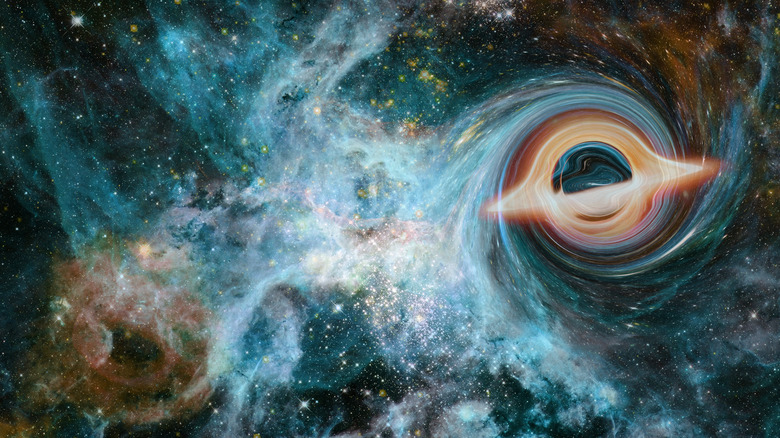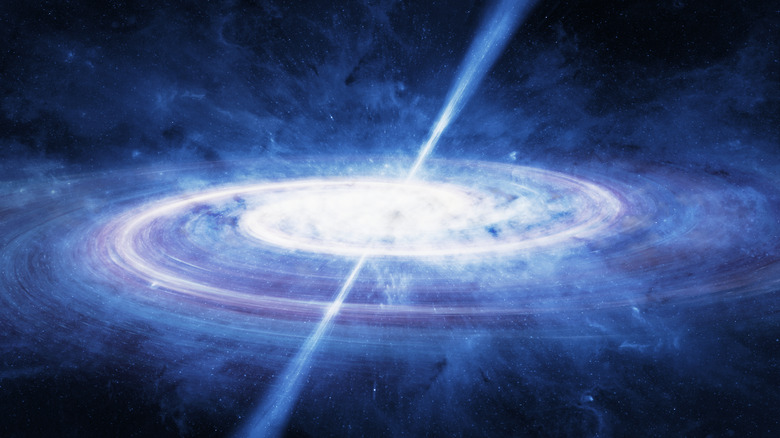How Big Can A Black Hole Get?
The words "black hole" tend to conjure images of massive cosmic void-beasts gobbling up anything that gets close. And in a way, that's true. Black holes are so "massive" — they have a lot of "mass" — that not even light can escape them. Even the tiniest, like V723 Monoceros ("Unicorn"), is three times more massive than our sun (per Astrobites). It's so massive, as Sci-News explains, that it causes a nearby red giant star to bulge on its side, kind of like how our moon causes tides. So the dimensions of "Unicorn," you might guess — radius, diameter — must be pretty big, right? But no. As Gigazine states, it's only 17.2 kilometers across — about 10.5 miles. That's about the size of Paris.
The asymmetry between mass and size is part of what makes black holes so unique. The supermassive black hole Sagittarius A at the center of the Milky Way galaxy is big, to be sure; its radius is 17 times that of our sun. If it were hanging out where the sun is, as Astronomy explains, it would eat up Mercury. But its mass? Not a paltry 17 times more than our sun, but 4 million times. And as far as supermassive black holes are concerned, it's on the baby-sized side.
Whatever comes into contact with a black hole makes it bigger, even another black hole, like the collision NASA recorded in November, 2021. But how big can a black hole get? The short answer is: practically limitless.
From supermassive to ultramassive
For most objects in the cosmos, like stars, there's an upper limit to how big they can get, determined by lots of complicated conditions (per Futurism). A star stays burning so long as it maintains a balance between outward-moving radiation pressure and inward-tugging gravity, and it's got fuel to burn (hydrogen, helium, and so forth). The greater the mass, the higher the temperature, the more quickly it burns out, and the greater the likelihood it'll explode and collapse into a black hole. Too massive, beyond 150 times the mass of our sun or so (as EarthSky says), and a star simply isn't stable enough to exist.
Black holes have no such mathematical-physical limitations. As Insider explains, the supermassive black hole at the center of our astronomical neighbor, the Andromeda galaxy, has a diameter as big as Jupiter's revolution around our sun, 516 million miles. Its mass isn't a mere 4 million times that of the sun, like Sagittarius A at the center of the Milky Way, but 140 million times. The supermassive black hole at the center of Messier 87? It's 24 billion miles across, with a mass of 6.5 billion suns. The largest black hole we've discovered, per Space? Ton 618, a brain-shattering 66 billion times more massive than the sun. You could chuck several of our solar systems into its diameter.
Ton 618 is so big it's surpassed "supermassive" and become "ultramassive." But can black holes get bigger? Why yes, they can.
From ultramassive to SLABs
We haven't seen black holes bigger than Ton 618, but that doesn't mean they don't exist. All the stars and galaxies we can view – the "observable universe" – amount to a meager 4% of the entire universe, per Space. That's a 46-billion-light-year stretch out of a 23-trillion-light-year-in-diameter universe (per Astronomy) that likely contains 2 trillion galaxies (per Forbes).
So what kind of extra-ultra-super-mega black holes might dwell in all that vastness? Researchers such as Florian Kühnel, theoretical cosmologist at Ludwig Maximilian University in Munich, call them SLABs: "stupendously large black holes." These, as Space reports, may be as massive as 100 billion suns, and with equally gigantic dimensions.
A black hole's size is only limited by the conditions of its creation. We don't even know, for instance, how supermassive black holes got so big, let alone ultramassive black holes or SLABs. Stellar black holes — the kind caused by supernovae — get bigger by devouring stars, colliding with objects, being bombarded with radiation, that sort of thing. But given the age of the universe (13.8 billion years, per Inverse), supermassive black holes shouldn't even be able to exist; there's no time for them to have gotten so big.
To explain super- and ultramassive black holes, we've got to turn to quasi-stars, theoretical suns with black holes for cores. As New Scientist explains, quasi-stars would have been able to form only in the earliest stages of the universe, and eaten their own starry shells.
The bigger they are, the longer they live
No matter how big black holes can get, they can also shrink in size by losing Hawking radiation (via Forbes). But, the rate at which black holes shrink is vastly slower than the rate at which they grow.
As Big Think summarizes, a tiny black hole 50 times the mass of the sun would take about 1068 years to dissipate. That's 1 followed by 68 zeros. It's also 757 times longer than the current age of the universe. And remember Ton 618? It's not 50 times more massive than the sun, but 66 billion times more massive. How long until such a monster vanishes forever? We're going to say, "might as well be infinity." Black holes will be the last thing to exist in our universe besides a smear of background radiation and scattered light. That era of the universe, its Dark Era, will comprise most of the cosmos' life.
During all this time, could behemoth black holes continue to grow as they collide with other stellar objects? The answer is: eventually, no. The expansion of the universe will wind up pulling all objects out of range of each other. Could new black holes continue to be born? Yes, but only normal-sized ones from supernovae. At the same time, through a process called "cosmological coupling," as Space explains, the expansion of the universe could essentially stretch out black holes and make them even bigger.



